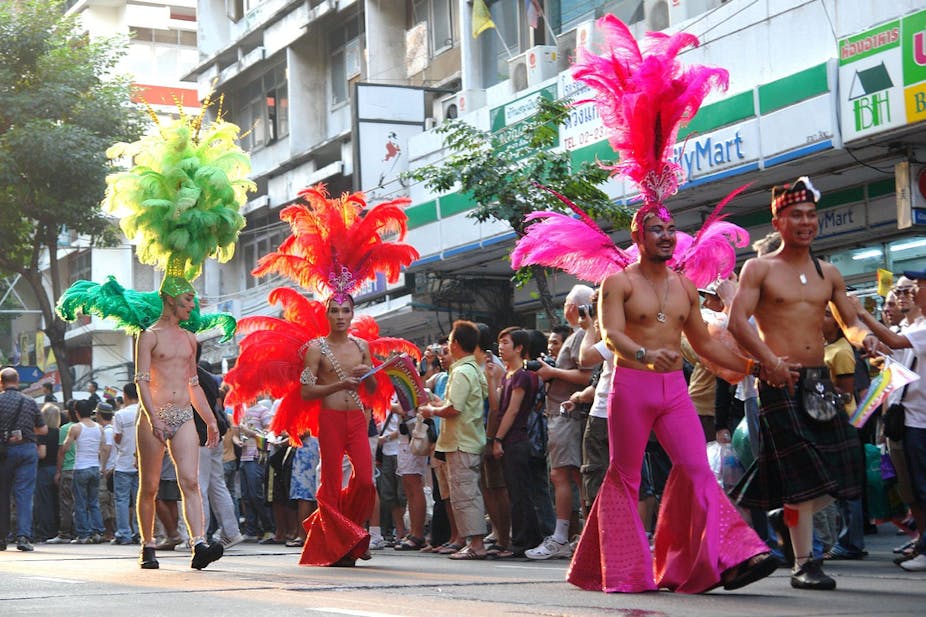It has been 10 years since the first evidence emerged of what was until then a completely hidden HIV epidemic among men who have sex with men in Bangkok, Thailand. The term includes all men who engage in sexual activity with other men regardless of how they or others identify them.
In 2003, about 17% of those randomly sampled from different Bangkok gay entertainment venues had HIV. When the study was repeated in 2005 prevalence had risen to more than 28%. A more recent study suggests it’s still around 30%. Similar epidemics have also been discovered in Chiang Mai, Phuket, Pattaya and other Thai cities, albeit at a slightly lower level.
While the Bangkok epidemic appears to have plateaued, HIV incidence (the number of new infections in a population over a certain time period) remains stubbornly high especially among the youngest men, despite years of investment in HIV prevention.
A persistent epidemic
There are a number of reasons that have led to, and sustained, the epidemic.
Thailand’s economy has been booming and there has been a significant increase in gay entertainment venues, including saunas, pubs and night clubs, and more men can afford to frequent these places. Internet apps on mobile phones and a plethora of gay dating websites have made hooking up for sex easier than ever before.
There has also been a growth in the use of party drugs such as crystal meth, which has been associated with high-risk practices.
Low condom use is a big problem. Condoms are widely associated with female prostitution, unfaithful (heterosexual) men and distrust in a sexual partner. Many young gay men do not consider themselves to be at high(er) risk for infection and think associating themselves with condoms may lower other people’s opinion of them.
In Thai sexual culture, men are allowed to have “fun”, but sexual liberty for women is still widely frowned upon. As long as their sex lives are kept out of public scrutiny, Thai men (including men who have sex with men) generally feel little guilt or discomfort in enjoying sex.
And while Thailand is widely considered in the west to be liberal and accepting towards homosexuality, in reality it’s tolerant rather than truly accepting. Heteronormativity – meaning that everything is focused on the needs and expectations of heterosexuals – permeates Thai society, including the education system. The sexual health needs of young homosexual men are completely ignored, and they do not receive relevant sexuality education in schools.
Another factor aiding HIV transmission is that homosexual relationships have been traditionally defined by difference; lovers should complement each other, rather than be similar. Many Thai men define homosexuality in gender-terms, with a masculine “top” and a feminine “bottom”; usually “bottoms” are hesitant to discuss condoms, leaving the decision to use them to the “top”.
Age-discrepant relationships (between a young man and a older man) are also common and could be a factor in the rise of HIV in the youngest age groups. Thais learn from an early age to respect and be docile towards older people and not question their judgement, which may also affect condom use.
Deafening silence
There’s a deafening silence around HIV. Most men with HIV don’t know they have it or don’t disclose their status to their families, friends and lovers. The topic is rarely, if ever, discussed in public. More anonymous and free HIV testing services would help enrol more men in treatment and reduce the “community viral load”.
Condoms, lubricants and information about testing have to become part and parcel of the entire entertainment environment, including the internet.
The 15-22 age group has to be specifically targeted with relevant sexuality education, since HIV incidence is especially high here given the shorter time they have been sexually active. Unfortunately, the Thai Ministry of Education is not known for its sense of responsibility for sexual health, let alone homosexual health. More schools could be recruited to initiatives (including web and social media-based ones) run by NGOs, as is already starting to happen in some places.
The older strata of same-sex attracted men also face higher HIV prevalence levels from longer exposure. Older men should mobilised to help protect younger men, who are often unable and unwilling to discuss condom use, especially in the context of age-discrepant relationships.
Public health campaigns fail to engage with the complexity of HIV infection. The message “always use a condom” is too simplistic and doesn’t distinguish between different gradations of risk between oral, anal and vaginal sex, insertive or receptive positions, the availability of water-based lubricants (which don’t degrade condoms) and whether unprotected orgasms happen inside or outside the body.
Anal sex is estimated to be up to 10 times more efficient at transmitting HIV than vaginal sex. Few people know this, and not enough people know that oral sex is virtually risk-free for HIV transmission. Small things, such as encouraging more oral sex instead of anal sex could make a huge difference in a reinvigorated push for prevention. A stronger focus on encouraging regular testing and the benefits of earlier HIV treatment is also needed.
It’s clear there are no quick answers, but a concerted push at “combination prevention” still offers the best hope for an HIV-free generation of gay men in Thailand.

